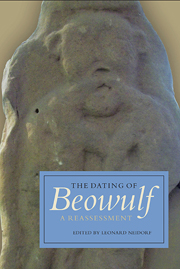Book contents
- Frontmatter
- Contents
- List of Tables
- List of Illustrations
- List of Contributors
- Acknowledgements
- Introduction
- 1 Beowulf and Language History
- 2 Germanic Legend, Scribal Errors, and Cultural Change
- 3 Names in Beowulf and Anglo-Saxon England
- 4 The Limits of Conservative Composition in Old English Poetry
- 5 The Date of Composition of Beowulf and the Evidence of Metrical Evolution
- 6 Beowulf and the Containment of Scyld in the West Saxon Royal Genealogy
- 7 History and Fiction in the Frisian Raid
- 8 ‘Give the People What They Want’: Historiography and Rhetorical History of the Dating of Beowulf Controversy
- 9 A Note on the Other Heorot
- 10 Beowulf and Conversion History
- 11 Material Monsters and Semantic Shifts
- 12 Scandals in Toronto: Kaluza's Law and Transliteration Errors
- 13 Afterword: Beowulf and Everything Else
- Index
6 - Beowulf and the Containment of Scyld in the West Saxon Royal Genealogy
Published online by Cambridge University Press: 05 October 2014
- Frontmatter
- Contents
- List of Tables
- List of Illustrations
- List of Contributors
- Acknowledgements
- Introduction
- 1 Beowulf and Language History
- 2 Germanic Legend, Scribal Errors, and Cultural Change
- 3 Names in Beowulf and Anglo-Saxon England
- 4 The Limits of Conservative Composition in Old English Poetry
- 5 The Date of Composition of Beowulf and the Evidence of Metrical Evolution
- 6 Beowulf and the Containment of Scyld in the West Saxon Royal Genealogy
- 7 History and Fiction in the Frisian Raid
- 8 ‘Give the People What They Want’: Historiography and Rhetorical History of the Dating of Beowulf Controversy
- 9 A Note on the Other Heorot
- 10 Beowulf and Conversion History
- 11 Material Monsters and Semantic Shifts
- 12 Scandals in Toronto: Kaluza's Law and Transliteration Errors
- 13 Afterword: Beowulf and Everything Else
- Index
Summary
The correspondences between the names in the Scylding genealogy at the beginning of Beowulf and three names in the upper reaches of the genealogy of Æthelwulf in the Anglo-Saxon Chronicle, Beaw, Sceldwa and Sceaf, frequently appear in arguments for a late dating of Beowulf. But these arguments overlook many aspects of Æthelwulf's genealogy that disrupt their case for a late dating. As H. Munro Chadwick pointed out over a century ago, the forms Sceldwa and Beaw found in the Chronicle for Scyld and Beow are not West Saxon spellings, and the -wa suffix of Sceldwa and Tætwa suggests that these forms may be archaic. Thus spelling alone indicates that these names were probably copied from an older, non-West Saxon text. Furthermore, the very presence of these names in the royal pedigree is puzzling. On one level the presence of Scyld is easy to explain: Scyld and the Scyldings were famous in heroic legend, and his inclusion in Æthelwulf's pedigree provides reflected glory for the West Saxon dynasty and implies genealogical, political and cultural connections between the West Saxons and the Danes that could be useful for Alfred and his heirs to foster. But on another level his inclusion is rather surprising: according to genealogical conventions, the presence of Scyld implies that the West Saxon royal family is a cadet branch of the Scylding dynasty, and is thus potentially subordinate to Scandinavian rulers in England claiming direct descent from Scyld.
- Type
- Chapter
- Information
- The Dating of BeowulfA Reassessment, pp. 112 - 137Publisher: Boydell & BrewerPrint publication year: 2014



